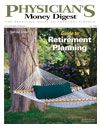Publication
Article
Physician's Money Digest
Phase into a Comfortable Retirement
There is no official definition of phased retirement, but it is widely viewed as a way to segue into full retirement through reduced work hours. Two of five workers aged 50 or older expressed interest in this concept, according to a recent AARP survey, though only one of five had even heard the term "phased retirement." Four of five workers interested in phased retirement said they would stay longer in the workforce if it was available, and one of three current retirees said they would have worked longer if phased retirement had been an option at their former job.
Mind and Money Benefits
Sometimes, retirees return to work because they did not save enough to live on during retirement, or they lack adequate health insurance until Medicare kicks in at age 65. Phasing into retirement allows workers to reduce the amount they need to save for full retirement, "practice" at retirement by living on a smaller income stream, and further build up their retirement accounts.
Proponents of phased retirement see benefits for workers that go beyond just financial advantages. Many workers receive important psychological, intellectual, and emotional rewards from work. This is especially true of physicians.
Another benefit of phasing into retirement is social. Colleagues comprise a social network, sometimes off the job as well as on. Retirees sometimes find themselves lonely if they don't have other social networks.
Some observers have argued that without these psychological and social underpinnings of work, as well as the loss of structured time, retirees may actually suffer a physical decline. Consequently, easing into retirement provides the worker a better chance to find alternatives that will substitute for these benefits, such as new friends or new hobbies.
Despite the benefits of phased retirement for workers, it is not available to many. A 1999 study by Wyatt Watson Worldwide found only 16% of large employers offered formal phased retirement programs. Physicians in private practice, in particular, may not be able to take advantage of the option without the help of an understanding partner or a cooperative replacement.
What's in the Works
A proposed change last fall in federal pension law by the US Treasury Department could make phased retirement more common. The proposed new private pension rules would allow workers to phase into retirement and simultaneously begin collecting a portion of their benefits from their employer's defined-benefit pension plan—something workers couldn't do before. To be eligible, participants must be at least age 59½ and must reduce their hours at least 20%.
The proposed rules also deal with another major concern for workers thinking about phasing into retirement: its potential impact on the calculation of their pension benefits. Normally, traditional pension benefits, as opposed to payouts from a defined-contribution plan such as a 401(k), are based on the number of years you work full time and the average amount of wages earned in the final years of work. Phased retirement could, consequently, reduce the amount that's paid out in monthly benefits or lump sum.
The proposed rules require employers to treat the employee "in the same manner as if the employee were still maintaining a full-time work schedule." Nonetheless, workers phasing into retirement could still see reduced lifetime pension benefits because their years of service would be less or their average income would be less. The proposed rules prevent employers from taking both into account at the same time.
Reprinted with permission from the Financial Planning Association (www.fpanet.org),
the membership organization for the financial planning community.
